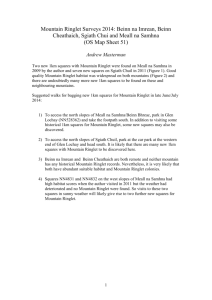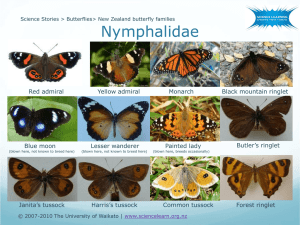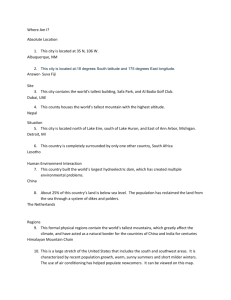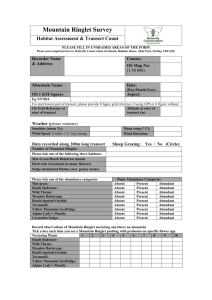Mountain Ringlet Action Plan
advertisement
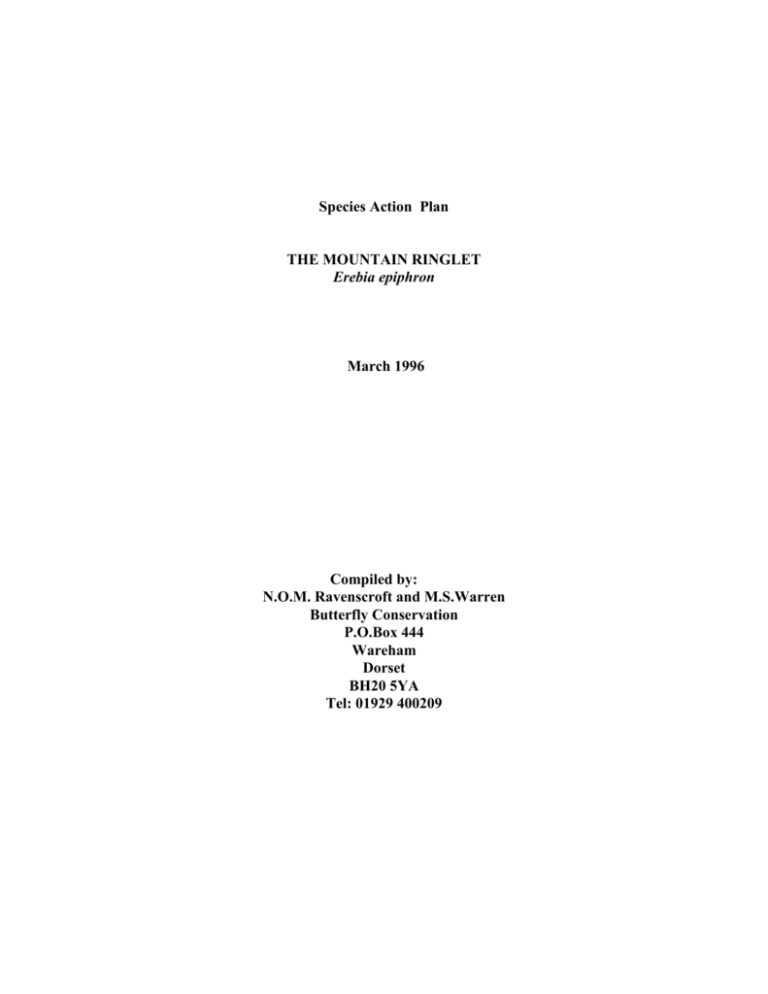
Species Action Plan THE MOUNTAIN RINGLET Erebia epiphron March 1996 Compiled by: N.O.M. Ravenscroft and M.S.Warren Butterfly Conservation P.O.Box 444 Wareham Dorset BH20 5YA Tel: 01929 400209 This species action plan is an unpublished working document produced by Butterfly Conservation to focus and co-ordinate the conservation of the Mountain Ringlet in the UK over the next five to ten years. It has been prepared under the Action for Butterflies project which is funded by WWF-UK, English Nature, the Countryside Council for Wales and Scottish Natural Heritage. The Action Plan was prepared in consultation with the following organisations in the hope that they will participate in the actions outlined: English Nature, Scottish Natural Heritage, National Trust for Scotland, National Trust, the John Muir Trust, Institute of Terrestrial Ecology, the Lake District National Park, Ministry of Agriculture Fisheries and Food and the Scottish Office Agriculture, Environment and Forestry Department. Outline Paper (first draft): ......................................................................... October 1995 Pathfinder Meeting: .............................................................................. November 1995 Second Draft: .......................................................................................... December 1995 Final Draft: ................................................................................................. January 1996 Acknowledgements We are grateful to the following for their comments at the Pathfinder meeting and / or on subsequent drafts: David Phillips, Chris Sydes and Peter Duncan (Scottish Natural Heritage); Dave Mardon (National Trust for Scotland); Neil Bayfield and Imogen Pearce (ITE); Keith Miller and Will Boyd-Wallis (John Muir Trust); Michael Harrison (MAFF); Matthew Oates and John Hooson (National Trust), Nigel Bourn, Paul Kirkland and Mo Richards (BC) and Phil Taylor (Lake District National Park). Butterfly Conservation Society (the British Butterfly Conservation Society) has an overriding objective to ensure a future for butterflies, moths and their habitats. In order to achieve this objective its aims are to raise public awareness of the plight of our butterflies and moths. to reduce the decline of commoner species and to increase the numbers of rarer species. to work with and advise other conservation groups, local bodies and agencies on techniques of land management which favour butterflies and moths and related wildlife. to acquire and manage habitats for butterflies and moths. to encourage the research (both at amateur and professional levels) on butterflies and moths. support and encourage butterfly and moth conservation world-wide Registered Office of Butterfly Conservation: Shakespeare House, High Street, Dedham, Colchester, Essex, CO7 6DE. Registered in England No. 2206468 Registered Charity No. 254937. 1 CONTENTS Page Summary 3 Part 1 Overview 1.1 Priority Statement 1.2 Broad Objectives 1.3 Legal Status 1.4 Status and Level of Biological Knowledge 4 4 4 5 Part 2 Biological Assessment 2.1 Introduction 2.2 Ecology 2.3 Distribution and Population 2.4 Limiting Factors 2.5 Resume of Conservation to Date 6 6 7 9 9 Part 3 Actions and Work Programme 3.1 Policy and Legislative 3.2 Site Safeguard and Acquisition 3.3 Land Management 3.4 Species Protection and Licensing 3.5 Advisory 3.6 International 3.7 Future Research, Survey and Monitoring 3.8 Communications and Publicity 3.9 Review Abbreviations 11 11 11 12 12 12 12 13 13 14 References 14 Appendix 1 The distribution of the Mountain Ringlet in the UK. 2 16 Summary The Mountain Ringlet is a nationally scarce species restricted to less than 50 10km squares in England and Scotland. It is protected under the Wildlife and Countryside Act with respect to sale only. A medium priority is given to the implementation of conservation action outlined in this plan. The British population is restricted to grassland on the mountains of the English Lake District and central Scotland. It is under-recorded, especially in Scotland, and its status requires further clarification, but it appears not to have declined or expanded markedly in recent years. The ecology and management requirements of the species are little understood and require further attention, but major threats to the species probably include overgrazing of its grassland habitat and succession caused by reduction of grazing. The major objectives of the plan are :- to ensure that existing populations are maintained, especially those on nature reserves; to conduct further research on the ecology and conservation requirements of the species; and to review the status of the species. The objectives of the plan will be achieved :- by ensuring appropriate management on known sites; by further surveys, followed by a review of the status of the species; by supporting further research into ecological topics specified in the Action Plan; and by maintaining current monitoring transects and establishing new transects. The Action Plan and the conservation of this butterfly will be publicised. Funds will be sought to implement proposed actions according to stated priorities. The Action Plan covers the next ten years, will be monitored every three years and reviewed in the year 2005 or such earlier time as the situation demands. 3 Part 1 Overview 1.1 PRIORITY STATEMENT The Mountain Ringlet Erebia epiphron is a nationally scarce species in the U.K. (NCC, 1989) and is confined to two areas; the Lake District and central Scotland. It is the only montane butterfly that occurs in the U.K.. Recent surveys suggest the butterfly is widespread in Scotland (Bayfield et al., 1995). Owing to the difficult terrain it inhabits, its status, ecology and conservation requirements are poorly understood, even on established sites. The Mountain Ringlet occurs across mountainous areas of Europe where it is not believed to be threatened. Medium priority should be afforded to implementing this plan. 1.2 BROAD OBJECTIVES 1. Maintain populations at all known sites. 2. Periodically review the butterfly's distribution and national status. 3. Conduct further research into the butterfly's ecology and management requirements. 1.3 LEGAL STATUS The Mountain Ringlet is listed on Schedule 5 of the 1981 Wildlife and Countryside Act for sale only. 4 1.4 Status and Level of Biological Knowledge Population -size Known from 38 10km squares in Scotland and 12 in the Lake District. Potential further 10 squares in Scotland. -trend, numbers Only known for one site in Scotland and a few in Cumbria. Evidence of some local fluctuations in Lake District. -trend, range Improved recording has increased known range. -status Moderate due to recent survey effort. -trends Poor. -conservation requirements Poor. Knowledge of 5 Part 2 Biological Assessment 2.1 INTRODUCTION The Mountain Ringlet Erebia epiphron is the only montane butterfly that occurs in the U.K.. It occurs mainly in patches of damp grassland (that is sometimes species-rich), on mountains of the Lake District and central Scotland where its primary foodplant is believed to be Mat Grass Nardus stricta, although other grasses may be used. 2.2 ECOLOGY The Mountain Ringlet is univoltine, flying from early June to late July in the Lake District and into early August in Scotland. The flight period is relatively short (2-4 weeks); the peak of the flight period is reached quickly after the first adults emerge in Scotland (Bayfield et al., 1995). Adults are strongly active only in sunshine and are generally inactive below 13-14C (Boyd-Wallis, 1994; Bayfield et al., 1995), although individuals may occasionally be seen on warm, overcast, even rainy, days. Adults take nectar from a variety of common plants but mainly Tormentil Potentilla erecta, Thyme Thymus praecox, Heath Spotted Orchid Dactylorhiza maculata, Meadow Buttercup Ranunculus acris and Heath Bedstraw Galium saxatile. Colonies in the Lake District usually occur in Nardus stricta-Galium saxatile heath (NVC community U5) (Shannon, 1995). At one site studied in Scotland (Creag Meagaidh NNR), adults were usually found in similar vegetation (NVC U5a) on sloping damp ground or taller Vaccinium myrtillus-Deschampsia flexuosa heath (NVC H18) on drier ground (BoydWallis, 1994). At another Scottish site (Ben Lawers NNR), two additional communities are used; Carex flushes (NVC M6b) and drier patches of more herb-rich grassland on rocky outcrops (NVC CG11) (Bayfield et al., 1995). The likely foodplant N. stricta is present throughout. Observing egg-laying is difficult and time-consuming; few records have been made in the field. Eggs are laid singly, close to the ground and usually on dead blades of grass. In Scotland, females select a variety of substrates, often dead blades of N. stricta at 3-6cm from the ground, but occasionally other plants such as mosses, Deer Grass Scirpus caespitosus, Flea Sedge Carex pilulifera and Red Fescue Festuca rubra which are common in the herbage layer (Boyd-Wallis, 1994). In the Lake District, eggs are also laid close to the ground (0.4-3.5cm, mean 1.6cm) but usually on dead blades of Sheep's Fescue F. ovina (Shannon, 1995). Eggs hatch after 25-29 days and in one field study fewer than 50% hatched successfully, although the sample size was small (Boyd-Wallis, 1994). Little is known about the ecology and requirements of the larval stages, or their parasites, despite recent efforts to locate and study them. Most reference texts state the foodplant as N. stricta (e.g. Brooks & Knight, 1982; Porter & Emmet, 1990). Larvae are known to 6 feed at night on the tips of N. stricta, retreating to the bases of tussocks during the day, but will take a variety of fine-bladed grasses in captivity (Porter & Emmet, 1990) where they feed just after dusk (N. Bayfield, pers. comm.). They hibernate in August or September, in the third instar, amongst grass, and emerge in the spring to bask and then re-commence feeding until pupation in late May or June. The butterfly possibly has a two-year life-cycle on some sites, as many moths do in the northern parts of their ranges. This has yet to be shown in the field but it has been demonstrated in captivity (Wheeler, 1982; N. Bayfield pers. comm.). In captivity, there are indications that F. ovina may be preferred over N. stricta (Bayfield et al., 1995), although the survival rates recorded suggest that foodplant conditions were not favourable. Like N. stricta, F. ovina is a constant in the vegetation recorded at sites in the Lake District (Shannon, 1995) and one site in Scotland (Bayfield et al., 1995) although it is infrequent from another (Boyd-Wallis, 1994). Full-grown larvae are 1920mm long, pupate on the ground or at the bases of tussocks and adults hatch after 18-22 days (Porter & Emmet, 1990). Most colonies occur on ground that is grazed to some extent by deer and sheep. There is little information on the grazing levels preferred by the butterfly and its management requirements are not yet fully understood. In Scotland, eggs were laid amongst vegetation that varied in height between 7-17cm and the species tends not to occur in rank, ungrazed grassland (Boyd-Wallis, 1994). Mean vegetation heights of areas used at Ben Lawers NNR were between 6-13cm (Bayfield et al., 1995). However, no conclusion can yet be drawn on appropriate grazing levels. Management on Creag Meagaidh NNR in Scotland, which is directed at reducing grazing pressure to promote woodland regeneration, will provide useful information on the tolerances of the Mountain Ringlet if the population continues to be monitored. Further information may also be obtained at Ben Lawers NNR where two exclosures (25ha and 5ha) have been established at the lower and upper altitudinal limits of the Mountain Ringlet to exclude all large herbivores and promote tree and shrub re-growth (D. Mardon, pers. comm.). 2.3 DISTRIBUTION AND POPULATION The Mountain Ringlet occurs across the mountains of Europe, from Spain east to the Carpathians and the Balkans and north to the Bavarian Alps (Porter & Emmet, 1990). It is one of a large complex of Erebia species that occur in the alpine habitats of Europe. There are numerous subspecies described throughout the European mountain ranges (Higgins & Riley, 1970). The British populations are described as subspecies E. e. mnemon in the Lake District and E. e. scotica in Scotland. The latter are generally larger and often have brighter coloration than E. e. mnemon (Porter & Emmet, 1990). They were first described in the U.K. near Ambleside (Lake District) in 1809 and the first Scottish specimens were described in 1844 (Heath, Pollard & Thomas, 1984). There are records of the butterfly in 7 Ireland during the last century and specimens exist in museums, although some authors dismiss these (Redway, 1981). Otherwise the known distribution of the butterfly has changed little. Currently, the Mountain Ringlet is known from 12 10km squares in the central Lake District. In Scotland, the butterfly is recorded from 38 squares centred on the mountains between Fort William to the west, the Grampians to the east (with scattered records in the Cairngorms), and Ben Lomond to the south. It occurs in four designated Environmentally Sensitive Areas: Lake District; Loch Lomond; Breadalbane and the Cairngorms. Colonies occur usually at altitudes between 500-700m in the Lake District (Porter & Emmet, 1990), although the species occurs here as low as 70-250m in some years (Anon, 1979). In Scotland, colonies occur between 350-900m (Boyd-Wallis, 1994) and occasionally over 1000m (Heath et al., 1984), but the highest densities usually occur between 450-800 (Thomson, 1980) (420-550m at Creag Meagaidh, (Boyd-Wallis, 1994)). Colonies are usually south-facing in Scotland but those studied in the Lake District have various aspects including northerly (Shannon, 1995; N. Bayfield & M. Richards, pers. comms.). A full analysis of aspect is required in the Lake District. Adults fly close to the ground and rarely rise above 30cm from the vegetation (Porter & Emmet, 1990). Males appear more active than females and move greater distances, up to 200m per flight (mean 25m) and 300m over four days (Bayfield et al., 1995). One male moved 1.3km in four hours (Boyd-Wallis, 1994). Females move less (mean 8m, up to 35m per flight) (Bayfield et al., 1995). However, females carry large egg burdens and their mobility is likely to increase as they become lighter. Studied populations occurred in patches separated by distances of 600m or more. The amount of inter-change of adults between these patches is not known but it seems likely that some occurs (Boyd-Wallis, 1994). In the Lake District, patches slowly shift position from year to year (K. Miller, pers. comm.). Otherwise, populations on mountains are thought to be isolated from others those on surrounding mountains (Heath et al., 1984). Colonies (i.e. areas where adults can be regularly seen) are difficult to define and may cover large areas of ground, but can occur on less than 1ha. At least 150ha of Creag Meagaidh NNR is occupied by the Mountain Ringlet (Boyd-Wallis, 1994). Population estimates at Creag Meagaidh suggest that colonies vary in size from 300-1700 adults and that the overall population may exceed 4000. Here, occupied patches vary in area from 12-50ha. In the Lake District one population studied consisted of 8500-9000 adults (Heath et al., 1984). Observations here suggest that the Mountain Ringlet is extremely abundant in some years when individuals can spread well below the normal altitudinal limits of distribution (Anon, 1979). Certainly, the probable foodplant N. stricta is extremely abundant and is common on 99% of mountains in the U.K. (Grime, Hodgson & Hunt, 1990). Factors controlling population size are not yet understood. Preliminary studies on the effects of climate change on the Mountain Ringlet at Ben Lawers suggest that 1°C or 2°C rises in mean temperature may reduce current habitat by 8 as much as 40%, although the effects on currently unsuitable habitat is unknown (French, 1995). 2.4 LIMITING FACTORS Historical No known change in distribution since records began, although local changes (cause unknown) have been recorded. Current and Future Limiting Factors (N.B. Limiting factors are difficult to assess owing to lack of ecological knowledge, but the following are probable). Changes in grazing pressure in montane habitats. Forestry in lower reaches of altitudinal limit. Possible long-term effects from global warming, acid rain and other pollution and tourism. 2.5 RESUME OF CONSERVATION TO DATE The Mountain Ringlet has been little studied, and apart from one short study on the species in the Lake District in 1976 by Keith Porter (Porter & Emmet, 1990), no ecological research had been performed on the species before 1992. Its distribution and status are also poorly known, mainly because of the difficult terrain it inhabits, the low density of recorders that visit such areas, and the generally unfavourable and unpredictable weather. Recorders have also tended to concentrate on known areas. Knowledge of its ecology and distribution has been improved recently by a three-year study by the Institute of Terrestrial Ecology commissioned by Scottish Natural Heritage in 1993. This focused on the well-known population at Ben Lawers NNR, Perthshire (which is managed by the National Trust for Scotland) with the primary aim of understanding the ecology and habitat requirements of the species and the effects of grazing (Bayfield et al., 1995). This population is the best known in the UK as it is also the sole Butterfly Monitoring Scheme site for the Mountain Ringlet. Short studies have also been commissioned by SNH at another NNR, Creag Meagaidh, near Loch Laggan, Inverness-shire (Baines, 1993; Boyd-Wallis, 1994; Pierce, 1995). Although these studies have gone some way to unravelling the requirements of the Mountain Ringlet in Scotland, much remains to be discovered. A transect was established in 1993 at Creag Meagaidh NNR specifically to monitor the Mountain Ringlet population on the reserve and its response to changes in management (namely the reduction of grazing pressure to promote 9 woodland regeneration). The species appears well represented on protected areas in Scotland and at least two other populations occur on NNRs (Glasdrum and Ben Lui). In the Lake District, studies on the long-term status and ecology of the Mountain Ringlet were started by Mo Richards and Keith Miller in 1992, later supported by Butterfly Conservation and the National Trust (Oates, 1993). In 1995, egg-laying by the butterfly was the subject of a M.Sc. thesis (Shannon, 1995). Most ground occupied by the Mountain Ringlet in the Lake District is managed by the National Trust, but large areas are also common land, making management a difficult issue (J.Hooson, pers. comm.). As yet, no population monitoring is being carried out in the Lake District, though timed counts exist for some sites and form useful base line data. 10 Part 3 Actions and Work Programme This section has been divided into the standard headings Policy and Legislative; Site Safeguard and Acquisition; Land Management; Species Protection and Licensing; Advisory; International; Future Research and Monitoring; Communications and Publicity; Review. Actions appear under one heading according to their major role and/or aim, and are given a low, medium or high priority. The lead organisation(s) concerned for each action is/are named. Lead organisation(s) concerned 3.1 POLICY AND LEGISLATIVE Action 1 PRIORITY: MEDIUM Take account of habitat requirements of Mountain Ringlet (once better known) when drawing up or revising prescriptions in relevant land management schemes and grants e.g. Habitat Scheme, ESAs (Lake District, Loch Lomond, Breadalbane, Cairngorms) and Woodland Grant Schemes. 3.2 SITE SAFEGUARD AND ACQUISITION Action 2 PRIORITY: HIGH Protect sites through management agreements and/or reserve acquisition where threats arise. 3.3 SOAEFD, MAFF, EN, FA, SNH ALL LAND MANAGEMENT Action 3 PRIORITY: HIGH Incorporate the requirements of the Mountain Ringlet (as far as is known) in all management plans for SSSIs and NNRs with colonies. 11 SNH, EN, LDNP, NT, NTS, RSPB 3.4 SPECIES PROTECTION AND LICENSING No actions proposed. 3.5 ADVISORY Action 4 PRIORITY: HIGH Advise site managers and landowners on the management requirements and habitat of the Mountain Ringlet as these become understood. 3.6 SNH, EN, NT, NTS, RSPB, ITE, BC INTERNATIONAL No actions proposed. 3.7 FUTURE RESEARCH, SURVEY AND MONITORING Action 5 PRIORITY: HIGH Conduct further research into the conservation ecology of the Mountain Ringlet, in particular: management requirements; habitat preferences; the ecology of the larval stages; population structure and dispersal. Action 6 SNH, EN, BC, ITE, Univs PRIORITY: MEDIUM Conduct further research into the biology of the Mountain Ringlet, including population dynamics and the role of parasites and the effects of global warming. 12 SNH, EN, BC, ITE, Univs Action 7 PRIORITY: HIGH Conduct further surveys to determine the overall distribution of the Mountain Ringlet; review status and occurrence on protected areas (to include location of largest colonies). Action 8 PRIORITY: HIGH Continue monitoring transects on NNRs and establish monitoring at a network of sites throughout the range of the Mountain Ringlet. Action 9 SNH, NTS, BC, EN, NT, ITE COMMUNICATIONS AND PUBLICITY Action 10 PRIORITY: MEDIUM Publicise this Action Plan. 3.9 NT, NTS, BC, ITE, SNH, EN PRIORITY: HIGH Review and assess effects of habitat management on population trends, especially at Creag Meagaidh NNR and Ben Lawers NNR. 3.8 BC, EN, SNH, LDNP, ITE, NT, NTS BC, EN, SNH REVIEW Action 11 PRIORITY: HIGH Monitor this Action Plan every three years and review every ten years. 13 BC Key to abbreviations ALL BC EN FA ITE LDNP MAFF NT NTS RSPB SNH SOAEFD Univs All organisations listed Butterfly Conservation English Nature Forestry Authority Institute of Terrestrial Ecology Lake District National Park Ministry of Agriculture, Fisheries and Food National Trust National Trust for Scotland Royal Society for the Protection of Birds Scottish Natural Heritage Scottish Office Agriculture, Environment and Forestry Department Universities References Anon. (1979). Insect Report. Birds in Cumbria, 1978, 52-53. Baines, M.M. (1993). Survey of the Small Mountain Ringlet on Creag Meagaidh NNR. Unpublished report to Scottish Natural Heritage. Bayfield, N., McGowan, G.M., Taylor, P., French, D.D., Mackie, E., Waterhouse, C. and Hartley, S. (1995). Small Mountain Ringlet project: field studies, rearing programme and questionairre survey 1994-95. Institute of Terrestrial Ecology. Unpublished report to Scottish Natural Heritage. Brooks, M. and Knight, C. (1982). A Complete Guide to British Butterflies. Johnathan Cape, London. Boyd-Wallis, W. (1994). Survey of Creag Meagaidh NNR for colonies of Small Mountain Ringlet butterfly. Unpublished report to Scottish Natural Heritage. French, D.D. (1995). Use of GIS to predict effects of environmental change on the small mountain ringlet at Ben Lawers. Institute of Terrestrial Ecology. Unpublished report to Scottish Natural Heritage. Grime, J.P., Hodgson, J.G. and Hunt, R. (1990). Comparative Plant Ecology. Unwin Hyman,London. Heath, J, Pollard, E. and Thomas, J.A. (1984). Atlas of Butterflies in Britain and Ireland. Viking. London. 14 Higgins, L.G. and Riley, N.D. (1970). A Field Guide to the Butterflies of Britain and Europe. Collins, London. Nature Conservancy Council (1989). Guidelines for the selection of SSSIs. Nature Conservancy Council, Peterborough. Oates, M. (1983). Small Mountain Ringlet survey- the ultimate challenge? Butterfly Conservation News, 53, 60-61. Pierce, A. (1995). A study of Small Mountain Ringlets (Erebia epiphron) at Creag Meagaidh NNR, July 1995. Unpublished report to Scottish Natural Heritage (NE region). Porter, K. and Maitland Emmet, A. (1990). The Mountain Ringlet. In: The Moths and Butterflies of Great Britain and Ireland, Vol 7, part 1, pp. 253-255. Harley Books, Colchester. Redway, D.B. (1981). Some comments on the reported occurrence of Erebia epiphron (Knoch) (lepidoptera: Satyridae) in Ireland during the nineteenth century. Entomologist's Gazette, 32, 157-159. Shannon, S. (1995). A study of the Small Mountain Ringlet butterfly Erebia epiphron Knoch. in south west Cumbria. Unpublished M.Sc. thesis, University of Leicester. Thomson, G. (1980). The Butterflies of Scotland. Croom Helm, London. Wheeler, A.S. (1982). Erebia epiphron Knoch (Lep., Satyridae) reared on a two-year life cycle. Proceedings of the British Entomological and Natural History Society, 15, 28. 15 Appendix 1 Distribution of the Mountain Ringlet in the UK (produced with kind permission of the Biological Records Centre). 16

